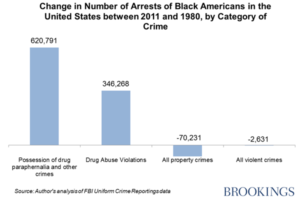
FBI Uniform Crime Reporting’s data revealed a very troubling trend.
While Blacks were being arrested less often for violent crimes and property crimes, the rate at which they were being arrested for drug crimes soared through the roof.
As Brookings’ Jonathan Rothwell explains, “As of 2011, drug crimes comprised 14 percent of all arrests and a miscellaneous category that includes ‘drug paraphernalia’ possession comprised an additional 31 percent of all arrests” for Blacks in the U.S.
What is even more troubling is that some studies suggest that Blacks don’t even use or sell drugs at the rate that other demographics do, yet they are still leading in arrests for such crimes.
The National Longitudinal Survey of Youth revealed that whites were actually 45 percent more likely to sell drugs than their Black counterparts in 1980.
A more recent study proved that this trend still exists today.
The 2012 National Survey on Drug Use and Health revealed that nearly 7 percent of white adolescents and young adults sold drugs.
Only 5 percent of Black adolescents and young adults sold drugs.
That statistics make a compelling case for the argument that racial profiling is leading to a vast majority of the arrests of Black citizens using or selling drugs.
That is not the only factor, however.
The statistics are also evidence of the different drug cultures that exist in Black communities and white ones, The Washington Post’s Christopher Ingram explains.

That’s enough to drive suspicion by authorities.
In white communities, on the other hand, drug deals are often conducted indoors between friends and family members.
Instead of dealing with strangers, many white dealers are selling paraphernalia to people they have met before and built relationships with.
Either way, Ingram believes the numbers suggest something even bigger.
Regarding the number of arrests of Blacks based on nonviolent drug-related crimes, “legalizing and decriminalizing certain drugs” could actually help solve “racial disparities in the criminal justice system.”
It’s important to note that it certainly won’t do away with the racial disparities, but it could be a major step in the right direction.


